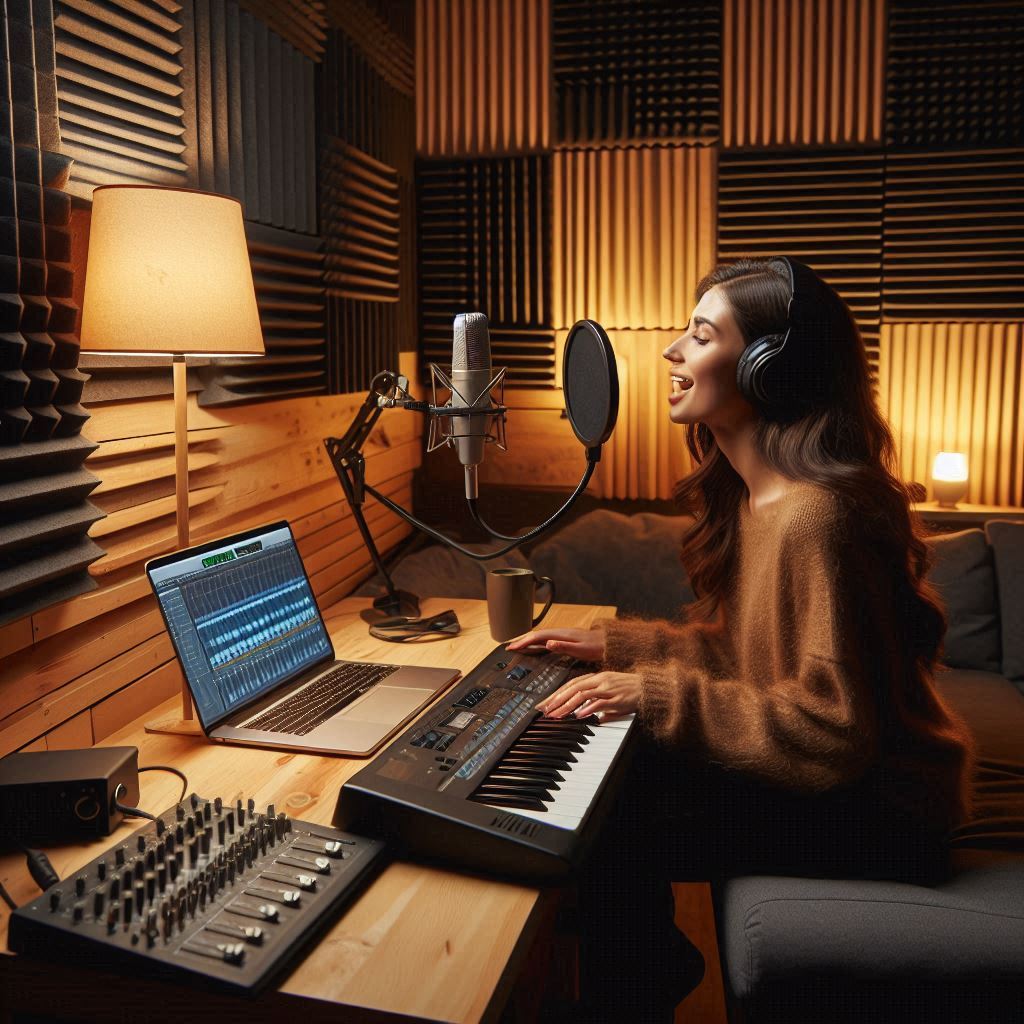Introduction
Recording vocals in a home studio can be a rewarding and cost-effective way to produce high-quality music. With the right equipment, setup, and techniques, you can achieve professional-sounding recordings without leaving your home. This guide provides a comprehensive overview of how to record vocals in a home studio, covering everything from the necessary gear to the recording process.
Thank you for reading this post, don't forget to subscribe!Essential Equipment for Vocal Recording
Microphones, Audio Interfaces, and More: To record high-quality vocals at home, you need the right equipment. Here are the essentials:
- Microphone: A good condenser microphone is ideal for capturing vocals due to its sensitivity and accuracy. Popular choices include the Audio-Technica AT2020, Shure SM7B, and Rode NT1-A.
- Audio Interface: This device converts analog signals (your voice) into digital signals for your computer. The Focusrite Scarlett 2i2 and PreSonus AudioBox USB 96 are excellent options.
- Pop Filter: A pop filter helps reduce plosive sounds (like “p” and “b” sounds) that can cause distortion.
- Headphones: Closed-back headphones like the Audio-Technica ATH-M50x allow you to monitor your recording without any bleed into the microphone.
- Mic Stand and Shock Mount: A sturdy mic stand and shock mount help isolate the microphone from vibrations and handling noise.
- Acoustic Treatment: Acoustic panels, bass traps, and diffusers help control the acoustics in your recording space, reducing reflections and echoes.
Setting Up Your Home Studio
Acoustic Treatment and Layout: The environment in which you record vocals significantly affects the quality of your recordings. Follow these tips for setting up your home studio:
- Choose the Right Room: Select a room with minimal external noise and as little echo as possible. Smaller rooms with carpeting and furniture are usually better.
- Acoustic Panels: Install acoustic panels on the walls to absorb sound reflections. Place them at ear level around your recording area.
- Bass Traps: Place bass traps in the corners of the room to absorb low-frequency sounds.
- Reflection Filter: Use a reflection filter behind your microphone to further reduce reflections and improve the clarity of your recordings.
Microphone Techniques
Placement and Usage Tips: Proper microphone placement is crucial for capturing the best vocal sound. Here are some techniques:
- Distance: Position the microphone about 6-12 inches from your mouth. Adjust the distance based on the volume and intensity of your singing.
- Angle: Angle the microphone slightly off-axis to reduce sibilance (harsh “s” sounds).
- Pop Filter: Place the pop filter about 2-3 inches in front of the microphone to prevent plosives.
- Vocal Booth: If possible, create a DIY vocal booth using blankets or foam to further isolate your recordings.
Pre-Recording Preparation
Warm-Ups and Vocal Care: Preparing your voice before recording is essential for achieving the best performance. Follow these steps:
- Warm-Up Exercises: Spend 10-15 minutes on vocal warm-ups to loosen your vocal cords and improve your range.
- Hydration: Stay hydrated by drinking plenty of water before and during the recording session.
- Avoid Dairy and Caffeine: These can cause mucus buildup and affect your vocal clarity.
- Rest: Ensure you’re well-rested to avoid vocal strain and fatigue.
The Recording Process
Step-by-Step Recording Guide: Recording vocals involves several steps. Here’s a guide to help you through the process:
- Set Levels: Adjust the input gain on your audio interface so that your loudest parts don’t peak above 0 dB. Aim for -6 dB to -3 dB.
- Monitor with Headphones: Use closed-back headphones to monitor your voice while recording.
- Record Multiple Takes: Record multiple takes of each section to capture the best performance.
- Stay Relaxed: Maintain a relaxed posture and focus on delivering an emotive performance.
Editing and Processing Vocals
Tips for Post-Production: Once you’ve recorded your vocals, the next step is editing and processing. Here are some tips:
- Comping: Combine the best parts of multiple takes to create a seamless vocal track.
- Noise Reduction: Use noise reduction plugins to remove background noise.
- EQ: Apply EQ to enhance the vocal tone, cutting unwanted frequencies and boosting others.
- Compression: Use compression to even out the dynamics and add presence to your vocals.
- Reverb and Delay: Add reverb and delay to create space and depth in your vocal track.
Avoiding Common Mistakes
Pitfalls to Watch Out For: Be aware of common mistakes that can affect the quality of your recordings:
- Overloading the Mic: Avoid recording too close to the microphone, which can cause distortion.
- Ignoring Room Acoustics: Poor room acoustics can ruin an otherwise great recording. Invest time in proper acoustic treatment.
- Inconsistent Performance: Ensure consistent vocal performance by practicing and staying focused during the recording session.
Finalizing Your Vocal Tracks
Mixing and Mastering Tips: Finalizing your vocal tracks involves mixing and mastering. Here are some tips:
- Balance Levels: Ensure your vocals sit well in the mix with other instruments.
- Automation: Use volume automation to maintain consistent vocal levels throughout the track.
- Mastering: Apply mastering techniques to enhance the overall sound and ensure it translates well across different playback systems.
FAQs
What equipment do I need to record vocals at home?
You need a good microphone, audio interface, pop filter, headphones, mic stand, shock mount, and acoustic treatment for your recording space.
How can I improve the acoustics in my home studio?
Use acoustic panels, bass traps, and a reflection filter to control sound reflections and improve the recording environment.
What is the best microphone for home vocal recording?
Popular choices include the Audio-Technica AT2020, Shure SM7B, and Rode NT1-A.
How do I avoid vocal strain during recording sessions?
Warm up your voice, stay hydrated, avoid dairy and caffeine, and ensure you’re well-rested before recording.
What are some common mistakes to avoid when recording vocals?
Avoid overloading the mic, ignoring room acoustics, and delivering inconsistent performances.
Conclusion
Recording vocals in a home studio requires the right equipment, proper setup, and effective techniques. By investing in quality gear, treating your recording space, and honing your vocal skills, you can achieve professional-quality recordings from the comfort of your home. Follow the steps outlined in this guide to enhance your recording process and produce impressive vocal tracks.



